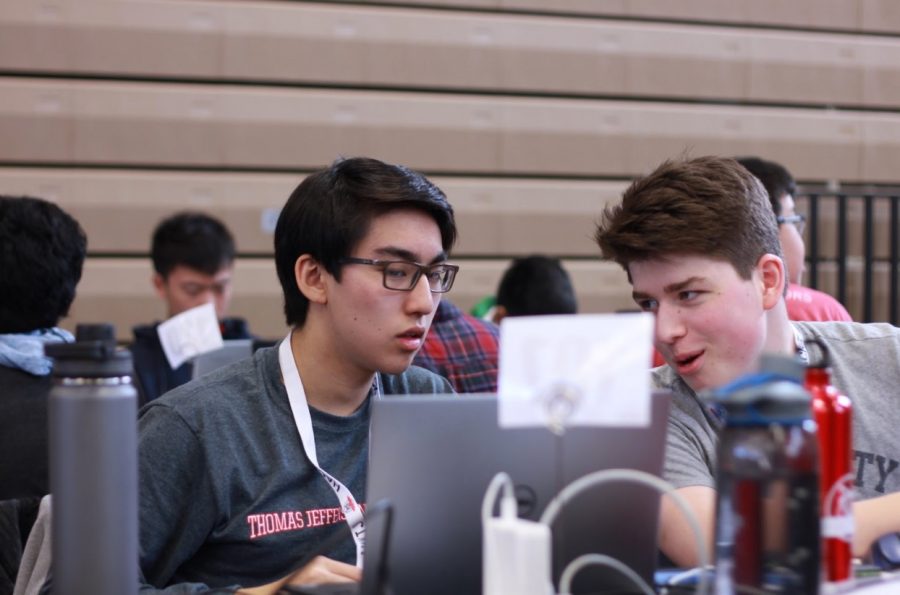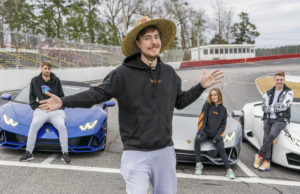HackTJ’s Backstage Crew
A look behind the scenes of planning one of the biggest high school hackathons in the country
Juniors Daniel Li and David Mead discuss their project while coding at HackTJ. Due to effective planning from the HackTJ team, students like Li and Mead were able to participate in and enjoy this event.
April 13, 2019
HackTJ: one of the largest high school hackathons in the U.S., hosted by Jefferson. A 24-hour experience featuring workshops, raffles, and various activities, HackTJ attracts over 500 students from high schools all over. An event as large as this requires detailed and elaborate planning—so what really goes into organizing HackTJ?
14 students and two teachers are the masterminds behind this hackathon. Senior and HackTJ director Reilly McBride notes the amount of work that goes into the execution of HackTJ. Starting at the end of last school year, the HackTJ team has dedicated numerous hours to ensuring that the event runs successfully.
“It’s a pretty big event; we have an almost $40,000 budget. So that’s a lot of planning—we’re meeting at least once a week and I think I spent half my lunch periods [planning] these past few weeks,” McBride said.
There are many aspects of HackTJ that attendants may take for granted that require careful planning by the HackTJ committee. In order to make the experience the best it can be for students, planners take their own experience into consideration and the team meticulously works out the details beforehand.
Senior team member Rachel Naidich further describes the thought behind their planning.
“We put a lot of thought and effort into improving our event every year. Since we go to hackathons ourselves, we know what types of things we would like to see,” Naidich said. “And we also take feedback from people who attend every year, so we always think about what people would want to see.”
In addition to this, McBride points out several of the more technical aspects of preparation.
“There’s a lot to consider … We’re planning mentors, parent volunteers, student volunteers to help set up, all the meals—we have to order all the food for like dinner, lunch, breakfast, snacks, all that … we set up workshops, we’re getting some TJ clubs to like sponsor workshops,” McBride said. “Obviously, all of registration has to go perfectly because we get 300 responses in the first hour, and we only have 520 seats, so that’s a big thing. There’s a lot of moving parts.”
The team expresses that one of the most challenging yet crucial parts of planning was contacting companies for sponsorships.
“We work with a bunch of different companies to sponsor us because it has to be free for all the participants,” McBride said. “Just getting people to respond and getting enough sponsors is always a big challenge. I’ll email people three times and only on the third time, they’re like, ‘Oh, yeah, hey, actually we do want to do this.’ I’m like, ‘Cool. That’d be great to know, a month ago.’”
Junior and lead sponsorship coordinator Sarah Wang echoes this sentiment.
“Contacting sponsors is difficult,” Wang said. “Sometimes it feels a little intimidating to email a person you don’t know and ask them for money.”
Team sponsor and computer science teacher Dan Tra adds on that the most difficult part of sponsorship process is the communication—due to HackTJ’s reputable history, actually gaining sponsorship did not prove to be as much of a challenge.
“The first and foremost [challenge] is getting financial support—being able to being able to contact companies, talking to the right people so that they can sponsor us,” Tra said. “The companies want to sponsor us. It’s just a matter of making the chain of communication work, so they can get that done. We’re lucky that this event has a history—from a new sponsors point of view, they don’t seem to have any trouble getting the money.”
The event required significant physical preparation as well—in order to ensure that students would have a positive experience at the event, the team spent a considerable amount of time getting supplies and setting up. The 24 hours that HackTJ was taking place did not come without its own challenges as well—the team had to stay alert managing all aspects of the event to make sure everything would run smoothly.
“The day before the event, we spent all day shopping for all the food for the event, and then setting up the event at TJ – so the tarps, tables, and chairs in the gym, power and internet stuff, and also just getting everything ready for sponsors,” sophomore team member Nishitha Vattikonda said. “We were the ones setting up, running, and cleaning up every single part of HackTJ. [We were] having to go from setting up meals, to taking down the setup and cleaning gym 2 for kids to sleep, and then setting back up everything for breakfast—we were always moving around because so many activities, like cup-stacking and workshops, were all happening so close together.”
Due to good communication, the team was able to overcome the obstacles they faced.
“Since there’s only 14 of us, it was sometimes difficult to set up things quickly because everyone has to be spread out,” Vattikonda said. “But I think we handled it well since we were all working really hard and moving around to help different activities based on what needed the most hands at the time.”
Despite facing challenges throughout the process, the team agrees that organizing the complexities and contributing to the project is a rewarding experience.
“It’s one thing to just organize any event and another thing to be a programmer and run HackTJ,” Nuha Mohammed, sophomore team member, said. “It was an exciting opportunity for me as a student to be contributing to HackTJ—from contacting sponsors to discussing merch to running around TJ on Friday setting up the whole event.”
Mr. Tra adds that after all the work that has gone into planning and all the obstacles the team has encountered, seeing students inspired at the actual event makes it worthwhile.
“A group of kids come in, and they’re not quite sure what to do. They don’t know what’s going on, and they they kind of try a couple of different things. But then they meet some people who help them make some kind of breakthrough—they either discover or some way of implementing something, or some new technology they want to try. Whatever it is that excites them, it clicks. And then they’re able to produce something wonderful out of it that would they wouldn’t have even thought of before coming in,” Tra said. “Those are the moments—before and after. It’s one thing to learn about programming in the classroom, but [another] to be able to see why paying attention to those details matters in an actual production. And those moments are the most meaningful and most valuable.”






